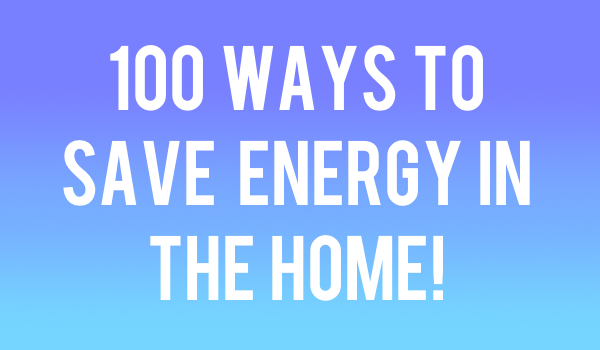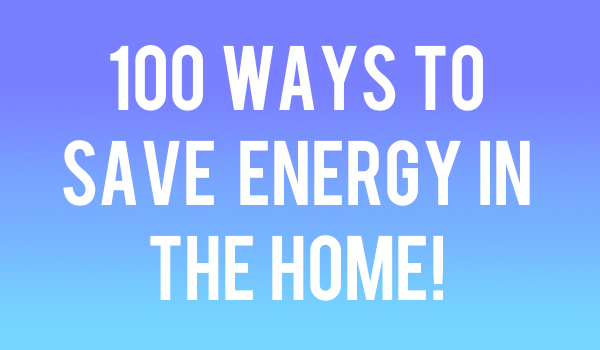[ad_1]

The ‘cost of living crisis’ is the expected to be most challenging event for families up and down the country as general price increases have now been coupled with exponential rises in energy costs.
With these tough times ahead we sat down TGA HQ the other day and thought long and hard how we can help the reader save on energy costs. The result: a 100 ways to save energy in the home! As far as we can tell, there are a few tips that seem to get recycled by every website and media outlet out there – so we decided to amalgamate them all together and create an exhaustive list.
In 2022 we’ve all experienced rapid increasing energy bills (80% rise in Oct 2022), and 2023 could be no exception – so this list should hopefully prevent you from paying out more in energy costs that you need to!
Have a read and let us know in the comments below if there are any other ways that we might have missed…
- Install insulation in the loft, this will help prevent heat escaping up through the top of your property (ideally 100% natural sheep wool).
- Install cavity wall insulation – again this is a cheap option (most energy companies offer it for free) and will help minimise heat loss through the walls of your home.
- Install a heat pump and take advantage of the RHI. If you boiler has packed up, try installing a renewable heating technology and the best bit, you get paid to produce the hot water by the government!
- Draught proof around your front door (including the letter box) to help prevent cold air rushing into your home during the winter months.
- Shower – don’t bath! Baths tend to use a huge amount of hot water compared to a shower.
- Limit the length of the aforementioned shower. We know that, sometimes, nothing beats a nice long shower; but if you can try and keep these extended stays to a minimum you are going to save energy and reduce your bills (especially if you have a water meter).
- Shut windows during the winter. It may seem a bit obvious, but if the heating is on and you are letting all the hot air escape straight out of the window, then you are wasting energy and money!
- Install heavy curtains and make sure you close them at night. This again acts as a barrier to prevent heat loss out of the home.
- Install chimney balloons or a chimney sheep – both work in the same way to stop cold draughts come down the chimney, just remember they are up there before you relight the fire!
- If you have a regular boiler, turn down the thermostat on the hot water tank. This will mean the water in the tank never gets too warm. There is little point producing scalding hot water in the tank if you then simply add cold water in your mixer shower or bath to get it to a nice comfortable temperature. Making sure it is heated to the right temperature (and stored at the right temperature too) in your hot water tank is a great way to save on your heating bill and this is done by turning down the thermostat on the tank.
- Insulate your hot water cylinder . If you have a hot water tank in your house, it is worth a trip down to the local DIY store to pick up a jacket to help limit heat loss.
- Install double or triple glazing – it is never that cheap to do, but it will improve the thermal comfort of your home and should save you a little bit on your energy bills every year.

- Install magnetic secondary glazing – this is cheaper to do than number 12, and is more effective in terms of noise reduction.
- Turn down the roomstat by a couple of degrees. 19 degrees is about the norm here in the Ireland. Some people do like their homes a bit warmer, but as a rule of thumb, for every degree you turn your thermostat down you will save about £50.
- Open windows instead of relying on an extractor fan – no electricity used, no cost!
- Set your fridge/freezer to a higher temperature so they don’t need to work so hard. If you are defrosting food, always defrost it in the fridge because then the frozen food will keep the fridge cooler!
- Replace your lighting with low energy LED lights, they not only use 90% less energy but they also last 10-20 times longer so you will hardly ever have to replace them.
- Take advantage of solar gain in the winter to keep your house warm (keep curtains open in the daytime to maximise direct light entering the house).
- Only buy A-rated appliances, or above. They are marginally more expensive, but in most cases the additional energy savings will cover the additional expense in just a year or two.
- Install motion detector lights. There is no point leaving lights on if no-one is there to benefit from them. Motion detector lights are also a good deterrent against unwanted visitors.
- Use microwaves to reheat food as opposed to the oven – they heat up the food far quicker so are therefore more efficient.
- Repair refrigerator door seals. If warm air is seeping into the fridge then it will need to work harder (and use more electricity in the process) to keep it at the set temperature.
- Fill your freezer up. It uses less energy since the frozen food won’t warm up when the door is opened. If the freezer is empty, then all the space will fill up with warm air when the door is opened, which the freezer needs to work hard to cool down when the door is shut again.
- Turn lights off when you leave the room. This is one that parents (who tend to pay the energy bills) forever tell their kids. It is definitely worth it, especially if you haven’t made the swap to LED lights (see no.17!)
- Avoid using the dryer – hang clothes outside when you can. Dryers have big motors to spin the clothes and heaters to help the drying process which means they are expensive bits of kit to run. If you can hang clothes outside you can normally get away without ironing them too because the wind does the work for you!
- If you do use a dryer, clean the lint filter after every couple of uses. This will help it run more efficiently, helping to save electricity.
- Try and maximise the use of the BBQ during the summer months – and use waste wood! This means no electricity or gas used in the home. Everyone much prefers BBQ food anyway!!
- Only boil as much water as you need – i.e. don’t boil a kettle full of water for one cup of tea.
- Always use your washing machine on the lowest temperature settings – bio washing powder contains enzymes that are specifically chosen because they work at this temperature. If you crank the temperature up then it can actually make the washing powder ineffective.
- Install tap aerators. These ‘inject’ air into the water as it comes out the tap, so while it looks like there is no impact on the flow rate, a fraction of the water is used. These are especially useful if you are on a water meter.
- Install a low flow shower head – same principle as number 30!
- If your washing machine doesn’t have a half load setting – make sure you fill it with clothes
- Plug things into a power strip and turn that off at the plug when not in use – to avoid leaving things in standby. Even though when things are in standby they use less energy, they do still use some! Turning everything off at the plug ensures that NO electricity is used.
- Don’t leave your computer in standby – turn it off at the end of each day
- Put Radflek (or other radiator reflectors) behind the radiators to reflect heat back into the room, the helps the radiators warm the room more effectively. GreenAge readers can get an exclusive 20% discount using offer code TGA20.
- Unplug your phone from the charger (and the charger from the wall) when your phone is fully charged
- Install a programmable thermostat – there is no point heating your home if you aren’t there. Better still, install a smart thermostat which you can control from outside your home. This will allow you to turn the heating on and off from wherever you are in the world, so if you suddenly realise you left the heating on while sitting on the sun bed in the Costa Del Sol you can turn it off to minimise wastage.
- Try to avoid electric heating – electricity is 4x the price of gas. If you don’t have a choice opt for infrared or if funds allow, try and push for a heat pump – these two types of electric heating are by far the most efficient.
- If you have tiled floors that get cold in the winter, cover the floor with a rug so your toes are kept nice and toasty warm!
- Air conditioning in some case might be necessary, but strategically placing trees can cause shading to help provide some comfort from direct sunlight.
- Install a new energy saving condensing boiler. If you have an old boiler in your house, it might be time to swap it to a new condensing version. This will recycle the heat in the waste exhaust gases making it run far more efficiently.
- If you can access the back of the refrigerator – try and vacuum the coils once a year to ensure the fridge runs at maximum efficiency
- Put lids on pots and pans to reduce cooking times.
- Try and match the size of the burner to the right pot or pan – putting a small pan on a huge burner or electric hob will just waste electricity.
- Don’t position the thermostat near the front door – any cold air entering the home will manipulate the temperature being recorded near the thermostat, forcing the boiler to fire up unnecessarily.
- Decorate with pale colours – soft tones reflect more light and therefore you should get away with using lower wattage bulbs and still achieve the same levels of illumination
- Keep the garage door shut at all times – normally garages in some way share a party wall / floor with the main house and therefore the warmer they are, the less heat will escape from the rooms adjacent to them
- Unplug any device that is not being used.
- Don’t oversize your appliances – a massive American style fridge is (normally!) unnecessary for a household of 1.
- Charge things at night if you are on an Economy 7 tariff, the night time tariff tends to be half the price of the day time tariff.
- Install insulation in the floor – this is not the cheapest thing to do, but if done when replacing the floor anyway then it is certainly worth doing. If the floor can be accessed from underneath, you can attach net ‘hammock’s underneath the joists which can be filled with insulation. Expect to save about 5-10% on your energy bills if you can insulate the entire floor.
- Make sure you use the dishwasher – these tend to use far less water than washing by hand – but be sure to put them on ECO mode to help minimise the energy used in the process (they use less water and heat it up to a slightly lower temperature).
- Turn your tap off while brushing your teeth – this is only really going to save on your water bills if you are metered, but is still good practise!
- Fill the sink with hot water before you shave – the same as above here although people tend to shave using hot water, so using a sink full rather than a running tap is better because you will use significantly less hot water.
- Watch less television – read a book instead! Reading a book is proven to be more relaxing than watching TV and a book doesn’t require electricity to run!

- Open a window instead of firing up the air conditioning unit – these are real energy guzzlers, so if do have the option of opening a window then you are going to save significantly on your electricity bills.
- Use glass and ceramic dishes if cooking in the oven, they hold heat better and mean that you can use a slightly lower temperature to cook food.
- Don’t open the oven to look at the food inside – peep through the window to help prevent the expensive hot air inside escaping.
- Avoid opening the fridge or freezer to browse – every time you do, the appliance will need to fire up to cool down the air again.
- Recycle your cardboard and old newspapers into logs using the ‘Logmaker’ – if you don’t have a fire to burn your paper logs on, then make sure you recycle paper rather than throwing it in the bin.
- Avoid drying clothes directly on your radiators as it lowers the room temperature, which means the boiler will need to work harder.
- Allow cooked food to cool before putting it in the fridge / freezer, otherwise the fridge / freezer will have to work harder to cool it down.
- If there are rooms that you rarely use – ensure that thermostatic valves are installed on the radiators – since these can be set to zero if the room is not in use so the space is not unnecessarily heated.
- Avoid blocking radiators with furniture – allowing convection currents to flow around the room as the hot air will be felt across the room quicker.
- Plant a tree in a south-facing garden to lower solar gain during the summer – the leaves should limit the amount of direct sunlight hitting your home (and in particular windows). This will limit the amount of cooling you need to do in your home e.g. air conditioning or a fan.
- If you have a ceiling fan, it should blow down in the winter and up in the summer, so you will need to turn the blades around to achieve this.
- On the loft hatch, ensure you attach insulation to the top of it, and then create a seal with draught proofing around the perimeter. So many people spend a huge amount insulating their lofts, but neglect the loft hatch completely meaning lots of heat escapes up through the hatch. If you are looking for a really simple way to save energy in the home, then ensuring the loft hatch is adequately insulated and draught proofed is a great way to get started!
- Keep curtains and blinds closed at night to keep cold air out – if you have especially cold rooms, you can get thick curtain linings to help increase their energy saving ability even further.
- Install solid wall insulation
- Use microwaves to cook food – they use only 20% of the energy required to run a full size oven.
- Recharge batteries instead of buying throw away ones.
- Recycle whatever you can – think plastic, paper and even food stuff (in a composter).
- Get a gas safe engineer to come and inspect your heating system once a year to make sure it is working at maximum efficiency. It is worth doing this just before the winter months because then hopefully they will be able to spot any potential issues before they actually materialise.
- Move in with your partner – save on heating and electricity!
- Carpooling saves fuel – find people at work who live close to you and take it in turns driving to work, someone to chat to on the way and you halve your fuel bill
- Holiday in Britain if possible (surfing in Cornwall is excellent!). As you might expect as we write this it is absolutely bucketing outside our office, but honestly the Ireland is a nice holiday destination just remember to take your raincoat!
- Grow your own fruit and veg in your garden – it not only saves you money, but you can save on fuel since you don’t need to go down to the shops so often. Also (and this is from first hand experience) home grown produce tastes better!
- Take a mug into work instead of using a new polystyrene cup each time.
- Although price comparison sites like USwitch became a bit irrelevant in 2022, do still follow updates and compare energy costs from time-to-time. Should energy costs rapidly decrease in 2023 and 2024, then cheaper energy tariffs in theory should come back.
- Dim your smart phone, it will use less energy so you won’t need to charge it so frequently (especially important if you have an iPhone!!)
- Likewise, turn off 3G/4G /Bluetooth where possible since they use more energy in this mode – it will save you money on charging
- When you go on holiday, turn all plugs off unless absolutely necessary – you don’t use a radio alarm if you aren’t at home!
- If you store things in your loft, make sure it doesn’t compress the insulation since it will lose some of its thermal insulating properties. Use loft lifters to raise the height of the joists – this allows you to make a solid storage platform in the loft while still allowing you to install the 300mm of insulation to maximise the energy savings.
- Inflate your tires car tyres – this lowers resistance on the road and saves on fuel.
- If the shops are a 10 minute walk away, don’t use the car!
- Fix leaking taps or toilets.
- Don’t store things permanently in the boot of the car – the extra weight needs to be shifted and this requires extra fuel
- Make sure the wireless thermostat is not above another a heating source like a wood burner or radiator – since it will give a false representation of the temperature. Likewise, if it is by a window or the front door, every time that is opened during the winter it will basically cool the air temperature down in the immediate vicinity of the thermostat. The thermostat will take this as a sign that the house is cold and will therefore instruct the boiler to fire up and for the heating to come on.
- Install a combi boiler instead of a regular boiler – combi boilers don’t require you to store hot water in hot water tanks and also you don’t need pumps to power showers
- Flush the toilet less often! A bit gross, but ‘if it’s yellow, let it mellow’. Not to the extent that your toilet smells though!
- Print on both sides of paper.
- Fill an old bottle up with water and store it in the fridge rather than running the tap cold every time you want a glass of water.
- Water the lawn first thing in the morning when temperature and wind speed are at the lowest – this will slow down evaporation, meaning less water will go further.
- Regularly defrost your freezer – ice building up in the freezer reduces its effectiveness.
- Leave food out to thaw before trying to cook it – this means less energy is required to cook it.
- Shower at work – let them pick up the bill! A naughty one, but useful especially if you get sweaty cycling to work or you go to the gym in the mornings.
- Get a thicker duvet for the winter
- Put on an extra jumper!
- Get a LCD or LED TV, they are more efficient than plasmas and way more efficient that old CRTs
- Hire an environmental consultant to get a tailor made view of where to achieve energy savings in your property.
If you can think of any other ways to save energy in the home – feel free to comment below!

[ad_2]


